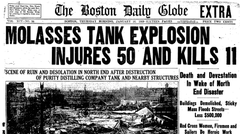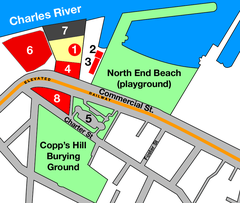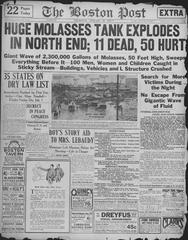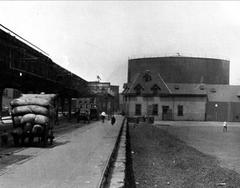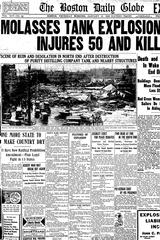
Great Molasses Flood Boston: Visiting Hours, Tickets, and Historical Site Guide
Date: 14/06/2025
Introduction
The Great Molasses Flood of 1919 is one of Boston’s most extraordinary and tragic historical events, marking a pivotal chapter in the city’s industrial and cultural legacy. On January 15, 1919, a storage tank containing over 2.3 million gallons of molasses ruptured in Boston’s North End, unleashing a deadly wave of syrup that tore through the streets at up to 35 miles per hour. The disaster claimed 21 lives, injured over 150 people, and caused extensive damage to buildings and infrastructure. Today, the site serves as both a memorial to those lost and a testament to the city’s resilience, offering visitors a unique opportunity to reflect on this remarkable episode in Boston’s history (Boston.gov; Wikipedia).
This comprehensive guide explores the history and cultural significance of the Great Molasses Flood, practical details for visiting the site—including hours, accessibility, and guided tour options—and tips for making the most of your visit to Boston’s vibrant North End. Whether you’re a history enthusiast or a casual traveler, discover how the legacy of the flood continues to shape both the city and national safety standards.
Table of Contents
- Historical Background and Significance
- Aftermath and Legacy
- Visiting the Site
- Frequently Asked Questions
- Visuals and Interactive Elements
- Summary and Final Tips
- Sources
Historical Background and Significance
Boston’s North End: Industry and Immigration
In the early 20th century, Boston’s North End was a densely populated community teeming with immigrants, particularly Italian Americans. Its strategic waterfront position made it a hub for industries reliant on maritime shipping, including the storage and distribution of commodities like molasses—an important ingredient for alcohol production and, during World War I, munitions (History Skills).
The Molasses Tank: Design and Flaws
The Purity Distilling Company’s massive steel tank, built in 1915 at 529 Commercial Street, was poorly designed and hastily constructed to meet wartime demand. Persistent leaks and structural weaknesses were well known to local residents and workers; attempts to mask these flaws with brown paint, rather than repairs, highlighted a culture of corporate negligence (Boston.com).
The Day of the Disaster
On January 15, 1919, a rapid temperature swing caused the tank’s contents to ferment, building up pressure inside. Around 12:30 p.m., the tank burst, unleashing a wall of molasses up to 40 feet high. The wave destroyed buildings, buckled railway tracks, and swept people, animals, and vehicles through the streets (Boston Uncovered; Britannica). Rescue efforts were hampered by the sticky syrup and freezing conditions, and the tragedy left a deep scar on the city (Boston.gov).
Aftermath and Legacy
Cleanup Efforts
The cleanup operation was monumental: over 300 workers, aided by the Boston Fire Department and Navy sailors, used saltwater, brooms, and saws to clear the thick molasses from streets and buildings. The molasses was tracked throughout the city and even reached as far as Worcester via public transport and rescue workers’ boots. The harbor remained brown for months, and residents claimed they could still smell molasses on hot days for years to come (history.com; medium.com).
Legal and Regulatory Changes
A landmark class-action lawsuit held the United States Industrial Alcohol Company liable for the disaster. The court’s ruling mandated over $628,000 in damages to the victims—a sum equivalent to more than $9 million today. The case set new standards for corporate responsibility, requiring engineering oversight and building inspections for future projects (historyandmystery.org; Boston.gov).
Environmental and Urban Impact
Molasses seeped into the soil and water, discoloring Boston Harbor and altering the landscape. The disaster transformed the area from an industrial zone into recreational spaces, including Langone Park and Puopolo Park, which now house the primary memorials to the flood (atlasobscura.com).
Cultural Memory
The flood has become part of Bostonian folklore, referenced in literature, music, and humor. The phrase “slow as molasses in January” took on a new, ironic meaning. Memorial plaques and annual commemorations ensure the story is not forgotten (historyandmystery.org; Atlas Obscura).
Visiting the Site
Location and Getting There
The main site of the Great Molasses Flood is centered around Langone Park and Puopolo Park in Boston’s North End. The closest address is 529 Commercial Street. Visitors can easily access the area via public transit—Haymarket and North Station (Orange and Green Lines) are both a short walk away. Limited street and garage parking are available; public transport is recommended during peak times (Treksplorer).
Visiting Hours and Admission
Both Langone Park and Puopolo Park are open daily from dawn until dusk, year-round. There is no entrance fee or ticket required to visit the memorials or use the park facilities.
Accessibility
The parks are wheelchair accessible, with paved walkways and ramps throughout the site. Benches and shaded areas are available for rest, and public restrooms are nearby.
Guided Tours and Special Events
While there are no permanent guided tours solely focused on the flood, several local organizations include the site in their walking tours. Notably, Boston By Foot offers the “Dark Side of Boston” tour, which covers the Great Molasses Flood and other intriguing North End history (bostonbyfoot.org; VisitorFun). Special commemorations may take place on the disaster’s anniversary each January—check local event calendars for details.
Nearby Attractions
The North End is rich with historic and cultural sites, making it easy to combine your visit with other highlights:
- Paul Revere House: The colonial home of the famous patriot.
- Old North Church: Known for its role in Paul Revere’s midnight ride.
- Hanover Street: Lined with renowned Italian bakeries, cafes, and restaurants.
- Copp’s Hill Burying Ground: One of Boston’s oldest cemeteries.
- Christopher Columbus Waterfront Park: Offers scenic views and gardens (Step Boston; Treksplorer).
Visitor Tips
- Best Time to Visit: Spring through early fall offers the most pleasant weather and vibrant gardens.
- Footwear: Wear comfortable shoes for navigating cobblestone streets and park pathways.
- Photography: The memorial plaques and park scenery are best photographed in daylight.
- Food: Sample local Italian cuisine at nearby North End eateries after your visit.
- Etiquette: Respect the memorials and park users. Photography is permitted, but please be mindful of privacy.
Frequently Asked Questions
Q: What are the visiting hours for the Great Molasses Flood site?
A: Langone Park and Puopolo Park are open daily from dawn to dusk, year-round.
Q: Is there an entrance fee or ticket required?
A: No, visiting the parks and memorials is free.
Q: Are guided tours available?
A: Yes, several local organizations—including Boston By Foot—offer tours that feature the flood site as part of a broader North End experience.
Q: Is the site wheelchair accessible?
A: Yes, the parks and memorial areas have paved walkways and ramps.
Q: What else can I see nearby?
A: The North End includes Paul Revere House, Old North Church, Hanover Street’s food scene, and more.
Visuals and Interactive Elements
- Memorial plaque at Puopolo Park near the Great Molasses Flood site, Boston
Alt text: Great Molasses Flood memorial plaque at Puopolo Park in Boston’s North End - Langone Park, site of the Great Molasses Flood
Alt text: Langone Park, Boston’s North End, site of the Great Molasses Flood - Virtual Tours: Visit Boston Public Library’s digital archives or Boston.gov for historical photos and videos.
Summary and Final Tips
The Great Molasses Flood site serves as both a memorial to the victims and a reminder of how tragedy can drive social change. The disaster led to significant reforms in building safety and corporate accountability, influencing standards across the United States. Today, visitors experience not only a poignant piece of Boston’s history but also the lively atmosphere of the North End—complete with historic landmarks and world-class dining.
For an enhanced visit, consider joining a guided walking tour or using the Audiala app for self-guided audio tours and historical context. By exploring this site, you connect with a pivotal moment in Boston’s past and gain insight into the enduring strength and character of its community.
Sources
- Boston.com: Great Molasses Flood Questions
- Boston.gov: 100 Years Ago Today, Molasses Crashes Through Boston’s North End
- History.com: The Great Molasses Flood of 1919
- New England Historical Society: Great Boston Molasses Disaster 1919
- Wikipedia: Great Molasses Flood
- Atlas Obscura: Great Boston Molasses Flood Plaque
- Treksplorer: Visiting the North End
- VisitorFun: Behind the Scenes of The Dark Side of Boston Tour
- Step Boston: Things to Do in North End

